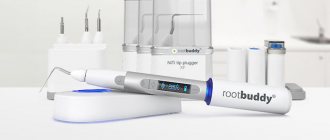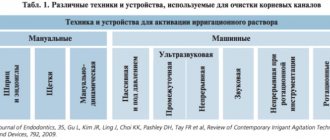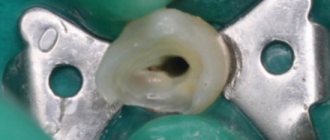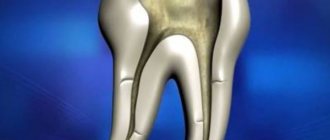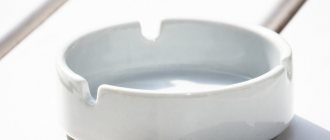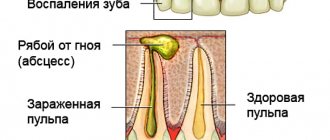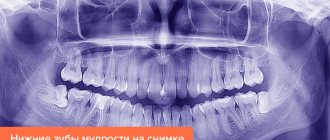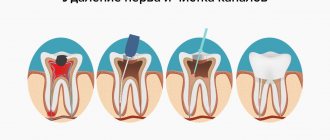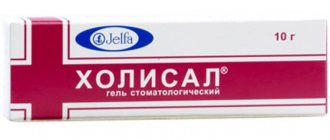1140
The filling method is used to treat many dental diseases. One of its varieties is root canal obturation.
It is performed in various ways, using a variety of filling materials. What are the main indications for this procedure and how it works will be discussed in this article.
What is root canal obturation?
The concept of obturation means a blockage that is formed due to pathological processes in a hollow organ, as well as the surrounding tissues or due to external influences.
Dental specialists perceive the term obturation as filling the canal openings of the tooth roots.
The purpose of the operation is to clean the canal passages from affected tissue, necrosis, pus and treat the affected area with antiseptic drugs, followed by closing the hole with a sealed material.
Lateral condensation method
The method has been used for a long period of time; it is quite simple, but at the same time reliable and effective. During lateral condensation, the tooth canal is tightly filled with gutta-percha pins, which are treated with a sealer that quickly hardens. The insertion begins with the central pin and ends with thin side pins, after which the material is carefully compacted. This method can lead to inflammation due to the heterogeneity of the material in the dental canal; in addition, a fracture of the tooth root is possible.
Materials used
When choosing materials and tools, you should check them for compliance with sanitary requirements:
- the means used must ensure hermetic filling of cavities and channels;
- no shrinkage after installation;
- moisture resistance;
- inability to support bacterial growth;
- possibility of sterilization before use;
- X-ray contrast;
- hypoallergenic;
- ease of removal if necessary.
| Materials and instruments used when filling tooth root canals _ | |
| Gutta-percha points | They are made on the basis of gutta-percha and come in standard and non-standard sizes (cones with a thickening at the base). The composition also includes: zinc oxide, wax, metal salts and biological substances that prevent oxidation. |
| Sealers | They provide a hermetically sealed filling of the canal, which reduces the risk of developing an inflammatory process and allows the pin to enter the tissue more easily. The main parameters of the sealer: fluidity, good adhesion, hardening speed. |
| Channel filler | The spiral-shaped instrument resembles the natural shape of the root canal. Used to fill filling material and paste into the canal hole. Operates at a rotation speed of 100-200 rpm. |
| Gutta condenser | The contra-angle tip of the tool, due to its ability to rotate, pushes the filler into the channel passage. Due to the friction force, the material softens, which ensures compaction in the apical part. |
| Spreader | Function of the instrument: to spread and distribute gutta-percha, ensuring lateral compaction. The surface of the spreader is smooth, pointed at the working part. Used for lateral condensation of master pins in the channel hole. |
| Heating plugger | The plugger consists of two truncated rods that perform the following functions: one heats and introduces heated filling material into the canal cavity, the second provides condensation. |
| Plugger | A smooth, truncated rod used to vertically condense heated gutta-percha into the root opening. |
| Calamus Dual | The kit is used for three-dimensional obturation of root canals. Used in conjunction with a vertical condensation device or squirt technique. The device controls heating and injection speed. A special feature of the device is the accuracy of gutta-percha delivery. |
| Gutaest | Wireless obturator, used for vertical condensation of the canal with heated gutta-percha. The temperature of the sealing material is increased by a special thermoplugger attachment, which is capable of both heating gutta-percha and promoting rapid cooling, which eliminates the possibility of thermal burns when performing obturation. |
Calamus Dual
Guttaest
Gutta condenser
Gutta-percha points
Channel fillers
Heating plugger
Siler
Spereder
Shielder technology
The Shilder technique is based on the melting of gutta-percha and its vertical condensation.
Also known as vertical condensation of thermoplastic gutta-percha. This technique is distinct from lateral condensation. The first difference is the application of a small amount of sealer to the canal walls and minimally in the apex area, so as not to remove it during the condensation process. The pin is placed in the canal so that the sealer does not extend beyond the apical foramen.
The coronal part of the pin is heated and removed with a special device for heating the pins in the canal. A plugger is used for condensation. Thanks to its non-sharp tip, it compacts the gutta first in the apical direction. The walls of the heated gutta-percha are rotated to the center and placed in the apex area. The goal is to seal 3-4 mm of the apical third.
- The plugger should not come into contact with the canal walls
- Pre-treat the plugger with alcohol or cement powder to prevent sticking to gutta-percha.
- It is important to control the pressure with the instrument on gutta-percha.
- As soon as the plugger touches the gutta-percha, it is slowly removed from the canal and the softened material is condensed
- It is important to select a plugger according to the bend of the canal. You can pre-bend a tool with a small diameter
- Gutta-percha should not be advanced until the apical part is sufficiently warmed and condensed
After the apical third is qualitatively obturated, the process is continued in small segments of 2-4 mm to the mouth or to the desired level.
Permanent obstruction
There are two types of obturation used in dental practice: permanent and temporary.
The final stage of endodontic treatment involves the installation of a permanent filling.
Obturation of root canal openings is carried out with a biologically compatible filling material, which ensures hermetic closure of the cavity, fits tightly to the walls and has a long service life.
This effect is achieved by hardening solutions. There are several ways to install a permanent filling, the main differences being in the materials and equipment used.
A temporary filling is installed for the following purposes:
- in treatment aimed at relieving the inflammatory process, as well as in direct treatment of the source of inflammation with antiseptic drugs;
- when restoring cell regeneration in tissues in areas adjacent to the tooth;
- for channel isolation;
- for cleaning tubules and dentin roots with an antiseptic.
The peculiarity of temporary obturation is the use of non-hardening materials. The maximum period of use of the filling is 2 months, after which the condition of the dentin and root canals is monitored. The hole treated with an antiseptic is closed with a permanent filling.
Stages of tooth canal filling
Indications and contraindications
The procedure has a wide range of indications. These include simple clinical cases when treatment of the root part of the tooth is required, and manipulation against the background of complicated inflammatory processes, pathologies of periodontal tissue, and granulosa formations.
The technique also has its own contraindications, some of which are absolute, and some simply make the procedure ineffective:
- excessively narrow channel;
- curvature of the tooth root structure;
- pathology of the cavity shape;
- iatrogenic formations;
- apical destruction;
- open apex.
This is interesting: Periodontal pocket: causes of pathology, treatment and prevention The purpose of obturation of root canals with gutta-percha and the instruments used.
Preparation
The preparatory process is carried out taking into account the chosen method of sealing the root canal. The use of specialized equipment requires the selection of the appropriate tool.
For example, when installing an apical pin, you should select the appropriate size and trim its tip by 0.5-1 mm. Appropriate pluggers and equipment are also prepared.
Preparation for obturation:
- The use of specialized equipment requires the selection of the appropriate tool
cleaning all tissues affected by caries and installing fillings on the holes (except for the endodontic entrance);
- therapeutic procedures to eliminate periodontal problems;
- restoration work with the walls and surfaces of the tooth;
- if there is excessive salivation, the patient is offered the drug atropine (the solution is used to rinse the mouth half an hour before the onset of obturation).
Next, the dentist moves on to the next stage, which directly concerns the endodontic entrance:
- use of anesthesia (infiltration/conduction);
- opening access to the root canal (includes preparation of a cavity affected by caries, removal of the arch of the dental pocket where the nerves are located);
- extraction of tooth connective tissue and necrotic formations;
- determination of the parameters of the root canal opening (X-ray);
- treatment of the canal opening with medications and instruments;
- relieving inflammation (if any).
Experts do not recommend endodontic treatment to be carried out in one visit. In difficult cases, the period may drag on for several weeks.
Injection method
The injection method was put forward in 1977 by Yee. The difference between the injection method is that gutta-percha is softened and administered by injection.
To perform this technique, you need to use a special gun along with gutta-percha sticks and cartridges. The material becomes plastic when using a gun, after which it is introduced into the root canal without pressure with a flexible needle.
We invite you to read How to stop being afraid of dentists, tips and instructions
The needle enters with a remainder of 3–4 mm to the apical foramen. The introduced material is compacted vertically in the classical way.
An undoubted advantage is that the injection method is the most suitable option for obstructing wide canals, with destruction of bone tissue and with an unformed root.
Filling of tortuous and anatomically complex paths is also done using this method.
The obvious downside is that although the method seems simple, it takes time and experience to apply this technique well.
Methods of conducting
High demands are placed on the material used for filling. An option that meets all the criteria has not yet been developed.
But when using gutta-percha in combination with various instruments and insertion techniques, the highest quality result is achieved (dense and durable sealing of the tooth canal).
The material is quite elastic and softens when heated, which ensures uniform filling of the channel. In addition, it is non-toxic; when using such a filling, the periodontium is not irritated.
In addition to the quality of the tools and materials used, the result of the work is influenced by the skill of the dentist, since filling the root canal requires adherence to technique and high-precision movements.
Standard method
When filling a canal with gutta-percha, special tools are used to increase the volume of filler in the widest area of the hole.
A feature of the method is the correspondence of the parameters of the pin element and the channel hole, which ensures tight contact of the filling material with the walls.
This option of obturation became possible after specialists mastered the technique of modifying the configuration of the apical ledge.
In preparation for the operation, it is given a cylindrical appearance, similar to a standard gutta-percha rod.
When filling a canal with gutta-percha, special tools are used to increase the volume of filler in the widest area of the hole.
Stages of obturation according to the standard method:
- preparing the tooth for surgery, giving the apical stop a cylindrical shape;
- selection of a pin taking into account the parameters of the apical ledge;
- control of rod entry and compliance;
- treating the pin and canal walls with dental sealant, introducing it to its full depth;
- fixing the rod with sealer;
- filling the channel with auxiliary rods (sealant, spreader).
The advantages of the method are the simplicity of its implementation, the minimal probability of material falling out of the channel, and the reliability of sealing.
Chemical
The essence of the obturation method is to insert a rod of gutta-percha, pre-treated with chloroform, into the canal opening of the tooth root. As a working solution, it is allowed to use a solvent with similar properties.
Stages of obturation using chemical methods:
- The essence of the obturation method is to insert a gutta-percha rod, pre-treated with chloroform, into the canal opening of the tooth root.
preparation of the apical ledge to prepare the cavity;
- selection of a master pin (the length of the rod should be 2-3 mm less than the length of the channel, the diameter should be 2-3 times greater than the parameters of the tool used for installation);
- control of gutta-percha compliance (immersion of the pin into the cavity and marking at the level of the chewing surface of the tooth);
- control of the sharpened rod;
- treating the surface of the rod with a sealer, immersing it in a chloroform solution;
- under a certain pressure, the pin is inserted into the canal and pressed until the marker coincides with the chewing part of the crown;
- fragments of the rod treated with sealer fill the remaining voids.
To achieve maximum tightness, this method is sometimes complemented by lateral condensation.
Application of soft gutta-percha
Filling canals with heated gutta-percha
Obturation of heated soft gutta-percha ensures dense filling of all cavities of the root canal, regardless of the number of branches.
This method is called three-dimensional filling. The only drawback is the possibility of shrinkage of the material in the apical region.
The essence of the method is to use a special tool with a heat-generating effect.
The diameter of its tip is quite voluminous, so the dentist, during the preparation process, expands the apical ledge in the area that is close to the dental crown. As a result of manipulations, a cone-shaped hole is formed.
A special feature of the method is trimming the auxiliary master pin to obtain a sharp tip. Its length is selected 2-3 mm less than the depth of the apical ledge. The difficulty of obturation consists in repeatedly removing it from the canal for quick processing with a heated instrument.
Biological (two-stage) technique
Sometimes the structure of root canals can be quite complex, which reduces the effectiveness of obturation of many techniques.
In such cases, a two-stage biological technique is more suitable, the essence of which is to fill the channel openings separately.
Approximate treatment plan:
- performing obturation in the area where the canals branch (a cut and heated pin is used);
- filling each hole one by one with softened material;
- trimming the pin at the level of the lower border of the destruction of dental tissue;
- filling the tooth, including the top of the canal, using vertical condensation.
The essence of biological technology is to fill the channel holes individually
Lateral condensation (compaction)
Some methods have the disadvantage that the material shrinks upon contact with tissue fluid. Such problems can be avoided by using lateral condensation.
The method prevents gutta-percha from being pushed past the apical support, which contributes to the tightness of the canal filling.
Features of the operation:
- Lateral condensation of gutta-percha
in the process of preparing the apical zone, the dentist gives it a cone shape;
- the pin is selected according to the channel parameters;
- after insertion to the full depth of the rod, the quality of the fit is monitored (using X-ray);
- remove the pin, having previously made markings at the level of the tooth surface;
- having treated the canal walls or the surface of the master pin with sealer, insert it without heating to the full depth until the marking coincides with the control point;
- Using a spreader, the rod is moved to the canal wall, and the resulting cavity is filled with other pins, pre-treated with sealer.
The most difficult stage of the work is filling the upper part of the canal.
Thermafil technology
Thermofil technique is used in cases where the apical ledge has a funnel-shaped shape without a formed apex. To prevent the sealant from getting outside the canal, the open part is blocked using gutta-percha.
Obturation is performed using an injection needle, which is filled with a liquid solution previously brought to 160 degrees. The needle tip is immersed into the apical zone by a third and the filling material is slowly withdrawn, after which the instrument is quickly removed.
In one pass, the channel is filled with only a couple of millimeters of working solution. At the same time, constant cooling is ensured using special equipment. The manipulations are repeated until the level of the filling reaches the apical part.
Canal obturation with Thermafil system
Combined technique according to Solomonov
Solomonov, using his knowledge and experience, offers several variations of the combined obturation method, the essence of which is a combination of “hot” and “cold” techniques.
The hybrid method allows you to achieve maximum sealing of the root canals, taking into account the anatomical features and shape of the apical ledge.
The combination of vertical condensation and gutta-percha injection is considered a complex operation requiring high precision and speed of execution.
Currently, special system devices and instruments have been developed to facilitate combined obturation. In Russia, perhaps one noteworthy system, “E&Q Plus,” is presented on the dental market.
Its kit includes:
- a control unit that displays the temperature of the supplied gutta-percha;
- injection gun;
- a tip with various attachments that heat the filling material directly in the canal.
Hybrid technique of root canal obturation
Gutta-percha
In fact, the most necessary material for filling root canals is undoubtedly gutta-percha, which is used in almost any filling method. This material has the elasticity of rubber and is by its nature a close relative. Gutta-percha is obtained by evaporating the milky juice of special varieties of gutta-percha tree. Gutta-percha was first used for filling root canals in 1867 by Bowman.
We suggest you familiarize yourself with what kind of glue dental crowns are placed on. How can you glue a crown to a tooth at home?
ISO-standardized tapered pins contain the following components:
- gutta-percha;
- zinc oxide - as a filler;
- barium sulfate - for radiopacity;
- waxes - to obtain the required consistency;
- dyes and small amounts of trace elements (Guldener, 1993; Hülsmann, 1993).
Gutta-percha points are most often used in combination with so-called sealers.
Sealers are pastes for filling root canals, which are mixed from two components and serve to fill the gap between the canal wall and the gutta-percha pin/pins. Sealers also fill small branches of the root canal and lateral tubules.
There are two options for applying paste to fill the canal:
- first, using a canal filler (lentulo), the sealer is introduced into the canal, and then a gutta-percha pin is inserted, and the sealer is pushed towards the canal walls;
- The gutta-percha point is coated with a small amount of sealer and then inserted into the canal, thereby pushing the sealer into the canal.
This is what the “standard concept” of root canal filling looks like, which has been used by dentists in everyday practice for many decades. Sealers are pastes for filling root canals, which are mixed from two components and serve to fill the gap between the canal wall and gutta-percha pin.
In his dental clinic, the author also uses this effective and efficient method of filling root canals as part of the services covered by public health insurance: the sealer is inserted into the root canal on one (central) gutta-percha pin. The author has been using AH Plus material as a sealer for 7 years.
This method has some significant advantages: a ready-made conical gutta-percha pin, due to pressure, moves the sealer paste, previously introduced into the root canal (or introduced simultaneously with the pin), to the canal walls and distributes it over their entire surface. Most often, due to the pressure of the gutta-percha pin, the sealer paste also penetrates into the areas of the apical branches of the root canal. In many cases, at the root apex there is a branching of the main root canal, resembling a river delta.
However, in principle, as a result of mechanical treatment of the root canal, according to all the rules, only the main axial central root canal is developed. Most often, at the moment when a gutta-percha pin is inserted into the root canal, additional (lateral) tubules that are completely inaccessible for mechanical treatment are also filled with filling material, since the excess applied sealer under pressure inevitably penetrates laterally and apically (!), i.e. into in all possible directions.
However, this often leads to unwanted removal of the sealer paste beyond the physiological or even anatomical apical foramen. The question of the negative impact of this phenomenon remains controversial. For example, in Germany, the removal of filling material beyond the apical foramen is an indicator of insufficiently high-quality treatment, and American colleagues believe that it is the (insignificant) removal of filling material beyond the apical foramen that serves as a sign of a particularly successful root canal filling (puff).
As with many aspects of practical endodontics, unfortunately, there is no evidence-based medicine yet on the issue of the acceptable level of root canal filling. All conclusions are made purely empirically. A good confirmation of this is the way dentists treat the removal of filling material beyond the apical foramen.
Of course, whether negative consequences will be observed when the material is removed beyond the apical foramen depends on what material was used to fill the root canals and to what extent it was removed beyond the apex. Thus, slight removal of a biologically inert sealer beyond the apical foramen when used correctly is most likely safe.
In Germany, removal of filling material beyond the apical foramen is an indicator of insufficiently high-quality treatment. But the removal in a larger volume beyond the apex of a non-resorbable filling material with supposed cytotoxic properties (for example, the previously frequently used material Diaket, Seefeld) most likely poses a danger.
We invite you to familiarize yourself with What is dental restoration - VIP Dentist
In this case, if there is a significant amount of material removed beyond the apex, it is subsequently necessary to perform an operation of resection of the root apex. It all depends on the situation in a particular clinical case, i.e., it should be taken into account whether the material removed beyond the apex has an irritating effect on the periapical tissues.
There are completely new methods of filling root canals, which use ONLY heated gutta-percha (without sealer). When using these methods, gutta-percha softens to such an extent that, without the additional use of a sealer, it can penetrate into all the necessary areas of the root canal. The result is a hermetic root filling with good adaptation to the walls of the root canal.
Such methods (for example, the Thermafil system) are very rational, and therefore can be used as part of “generally available endodontic treatment”. However, the questions about whether it is necessary to abandon the additional use of sealer and whether a sufficiently sealed root filling is obtained without a sealer have not yet been finally clarified. There is also no evidence-based medicine on this important issue.
When briefly listing the current methods of filling root canals using gutta-percha, it is necessary to mention the methods of lateral condensation and vertical condensation (according to Schilder). These labor-intensive methods are used, as a rule, as private medical services and mainly by dentists specializing in the field of endodontics.
The author believes that due to the large investment of time and money, these methods are difficult to use as “standard” within the framework of “generally available endodontic treatment.” However, as a compromise solution, “mixed” methods can be used.
Filling with paste
The next step is to fill the root canal with endosealant. This can be done using a K-file, K-reamer or channel filler. The paste should be injected up to the apical foramen and distributed evenly over the walls.
We suggest you read: How to treat stomatitis in children at home?
It is important not to overdo the amount of material and not fill the channel completely. It is enough to fill one portion with channel filler, and 2-3 portions with hand tools.
